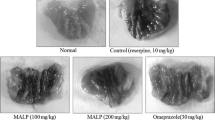Abstract
Oral FPL-52694 [5-(2-hydroxypropoxy)-8-propyl-4-oxo-4H-1-benzopyran-2-carboxylic acid Na], a new mast cell stabilizer, dose-dependently inhibited gastric acid secretion but increased the volume and pepsin output in pylorus-ligated rats. Intraduodenal FPL-52694 significantly inhibited all of the volume, acidity, acid output and pepsin output. Concerning the acidity, oral administration of the agent showed much more potent inhibition than intraduodenal administration. Oral FPL-52694 markedly inhibited the development of pylorus-ligated ulcers, water-immersion stress- and aspirin-induced gastric erosions and moderately inhibited the formation of reserpine-induced gastric erosions in rats. Intraduodenal FPL-52694 also inhibited pylorus-ligated ulcers whereas it had no effect on aspirin-induced gastric erosions. Histamine-induced gastric erosions were not affected by oral FPL-52694. These effects of FPL-52694 were almost the same as those of cimetidine, except that cimetidine tended to inhibit histamine-induced gastric erosions. Although the precise mechanism of action of FPL-52694 remains unknown, oral FPL-52694 appears to be a promising agent for the treatment of peptide ulcers.
Similar content being viewed by others
References
C. W. Ogle andH. K. Lau,Disodium cromoglycate: a novel gastric antiulcer agent?, Eur. J. Pharmac.55, 411–415 (1979).
A. K. Nicol, M. Thomas andJ. Wilson,Inhibition of gastric acid secretion by sodium cromoglycate and FPL-52694, J. Pharm. Pharmac.33, 554–556 (1981).
C. Andre, J. Gillon, B. Moulinier, A. Martin andM. C. Fargier,Randomised placebo-controlled double-blind trial of two dosages of sodium cromoglycate in treatment of varioliform gastritis: comparison with cimetidine, Gut23, 348–352 (1982).
H. A. Davies, J. Rhodes andM. Thomas,Inhibition of gastric acid secretion with a mast cell stabilizer, FPL-52694, Br. J. Clin. Pharmac.1, 53–56 (1981).
M. L. Anson,The estimation of pepsin, trypsin, papain and cathepsin with hemoglobin, J. gen. Physiol.22, 79–89 (1938).
H. Shay, S. A. Komarov, S. S. Fels, D. Meranze, M. Grunstein andH. Siplet,A simple method for the uniform production of gastric ulceration in the rat, Gastroenterology4, 43–61 (1945).
K. Takagi andS. Okabe,The effects of drugs on the production and recovery processes of the stress ulcer, Jap. J. Pharmac.18, 9–18 (1968).
K. Takagi, Y. Kasuya andK. Watanabe,Studies on the drugs for peptic ulcer. A reliable method for producing stress ulcer in rats, Chem. pharm. Bull., Tokyo,12, 465–472 (1964).
S. Okabe, K. Takeuchi, K. Nakamura andK. Takagi,Pathogenesis of gastric lesions induced by aspirin in the pylorus-ligated rat, Jap. J. Pharmac.24, 363–371 (1974).
S. Okabe, K. Takeuchi, T. Urushidani andK. Takagi,Effects of cimetidine, a histamine H 2-receptor antagonist, on various experimental gastric and duodenal ulcers, Am. J. dig. Dis.22, 677–684 (1977).
C. W. Dunnett,A multiple comparison procedure for comparing several treatments with a control, Am. J. Statist. Assn.50, 1096–1121 (1955).
P. H. Guth andP. Hall,Microcirculatory and mast cell changes in restraint-induced gastric ulcer, Gastroenterology50, 562–570 (1966).
P. H. Guth andX. Kozbur,Pathogenesis of gastric microcirculatory and mast cell changes in restraint stress, Am. J. dig. Dis.13, 530–535 (1968).
W. P. Ritchie, J. J. Breen, D. I. Grigg andO. Wangensteen,Effect of decreased levels of endogenous gastric tissue histamine on acid secretion and stress ulcer formation in the rat, Gut8, 32–35 (1967).
K. Fuchs, M. Eydt, H. W. Borger andU. Lindau, Gastric juice, endogenous histamine and gastrin in restraint stress. InExperimental Ulcer, pp. 209–214 (Ed.T. Gheorghiu). Gerhard Witzstrock, Baden-Baden 1975.
R. J. Levine andE. C. Senay,Histamine in the pathogenesis of stress ulcers in the rat, Am. J. Physiol.214, 892–895 (1968).
H. J. Reimann, W. Lorenz, M. Fischer, R. Frolich, H. J. Meyer andA. Schmai,Histamine and acute haemorrhagic lesions in rat gastric mucosa: Prevention of stress ulcer formation by (+)-catechin, an inhibitor of specific histidine decarboxylase in vitro, Agents and Actions7, 69–73 (1977)
W. Lorenz, M. Fischer, H. Rohde, H. Troidl, H. J. Reimann andCh. Ohmann,Histamine and stress ulcer: New components in organizing a sequential trial on cimetidine prophylaxis in seriously ill patients and definition of a special group at risk (severe polytrauma), Klin. Wschr.58, 653–665 (1980).
A. H. Soll, K. J. Levin andM. A. Beaven,Isolation of histamine-containing cells from rat gastric mucosa: Biochemical and morphological differences from mast cells, Gastroenterology80, 717–727 (1981).
M. A. Beaven, Factors regulating availability of histamine at tissue receptor. InPharmacology of Histamine Receptors, pp. 103–145 (EdsC. R. Ganellin andM. E. Parsons). Stonebridge Press, Bristol 1982.
Author information
Authors and Affiliations
Rights and permissions
About this article
Cite this article
Takeuchi, K., Ishihara, Y., Kunimi, H. et al. Effects of FPL-52694, a new mast cell stabilizer, on gastric secretion and various acute gastric lesions in rats. Agents and Actions 14, 637–642 (1984). https://doi.org/10.1007/BF01978900
Received:
Issue Date:
DOI: https://doi.org/10.1007/BF01978900




